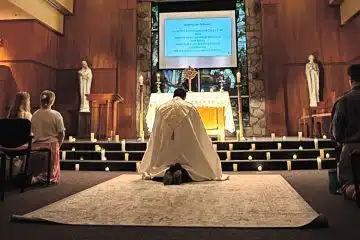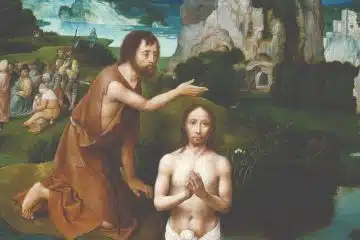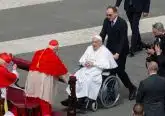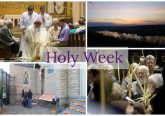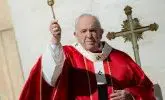Sunday Scripture: The contrasts in the Passion narrative
April 13, 2011
By Father Timothy Schehr
Palm Sunday of the Lord’s Passion: Isaiah 50:4-7; Philippians 2:6-11; Matthew 26:14 –27:66.
As we listen to the long Gospel this Sunday it may seem a bit shorter for us if we listen for some of Matthew’s key spiritual themes. One such theme is the contrast between the physical and the spiritual worlds. This is a favorite for Matthew, quite understandable if, as tradition holds, he was a tax collector who became an apostle. Often he uses the values of his former world to emphasize how much more valuable are the things of heaven.
As the reading begins Matthew records Judas accepting those silver pieces to betray his Lord. Then Matthew tells us about the Lord making preparations for the Passover supper. The first scene is about money; the second about God’s saving plan. Which scene carries more value?
Contrasts continue at the table. Matthew reminds us that it was getting dark, surely more than a note about the time. Once again we learn of the presence of the betrayer, this time even trying to hide behind the seemingly innocent question “Surely it is not I, Rabbi”? Other shadows enter with the prediction of Peter’s denial and the lack of faith in all the rest. In contrast, we see the steadfast Son of Man giving bread that is His body and wine that is His blood poured out on behalf of many of the forgiveness of sins.
In the garden of Gethsemane the Lord prays fervently three times expressing His commitment to the saving plan of His Father in heaven. He invites some of His apostles to prayer too, but fatigue settles in and, even though their spirit may be willing, their mortal nature is too weak to stand up to the test endured by their master.
Kingdoms clash as Judas arrives with a large crowd to take Jesus into custody. The crowd carries swords and clubs, the implements of this world to apprehend the Prince of Peace. Peter is fearless at this point drawing his own sword and wounding one of them. But Jesus commands Peter to return his sword. His kingdom is not of this world. All takes place according to God’s saving plan. God’s servant must suffer and die. It is no sign of defeat, but of ultimate victory over everything that stands in the way of salvation.
The schemes of this world come into play again in the presence of the high priest. They are ready to settle for false testimony to secure a verdict against Jesus. At the same time Jesus speaks the truth. They will soon enough see the prophecy of Daniel fulfilled about the Son of Man “seated at God’s right hand and coming on the clouds of heaven.” But the kingdom of this world twists the Lord’s words in blasphemy.
Matthew gives us one last look at Peter and Judas. Both filled with remorse. Peter weeps bitterly for his denials; Judas sees only death to escape his wrong.
Pilate offers the people a choice. They choose Barabbas over Jesus. Jesus is then mocked as a king. The readers know that, in fact, He is the king. The crowd challenges Jesus to save himself but He came to save others.
When Jesus dies there is already foreshadowings of Easter. Matthew speaks of open tombs and rising saints appearing after the resurrection of the Lord. In the closing scene Joseph of Arimathea buries the Lord in the finest of tombs and soldiers guard it. But it is not the end. The kingdom of earth will not prevail.
Father Schehr is a faculty member at the Athenaeum of Ohio.


